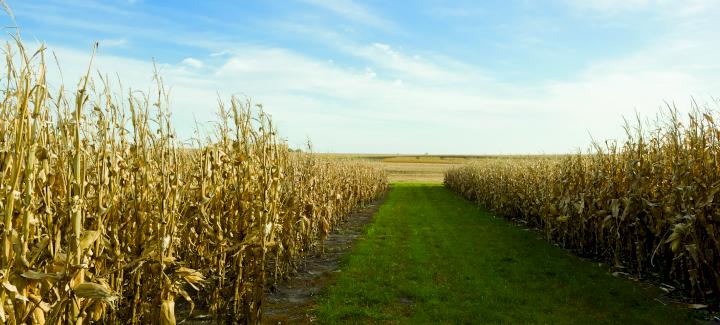
For growers who haven’t started corn harvest or who are deciding which field to harvest next, there’s one important thing to keep in mind. Now is the time to check your stalks for integrity and standability. There have been a lot of weather events mid-to-late season this year, so some stalk quality may be compromised. Get ahead and harvest areas that have the potential for lodging first.
How can I tell if my stalk quality is compromised?
It’s as easy as walking your fields. While discoloration can be an indicator that stalk quality is compromised, the old-fashioned push and pinch tests are the tried-and-true ways to check for standability issues.
The push test is good for checking stalk quality. To do this, you simply push the stalk over at roughly a 45-degree angle. If it kinks at the bottom and doesn’t return upright, that’s a good indication that your stalks are compromised.
The pinch test must be performed roughly about one-foot off the ground. To do this, use your thumb and forefinger to pinch down on the stalk, running your fingers up and down the stalk. If you can pinch to a point where the two sides of the stalk can nearly touch and the inside feels soft, there’s a good chance it’s compromised and could lodge. If the stalk is firm, you should have more time.
If you have trouble getting consistent results from the push or pinch tests, you can always cut open the stalk and more thoroughly examine up and down the inside of the stalk. And, of course, in any of the tests mentioned, always make sure you’re testing several plants at random throughout the field and not just one plant or one section.
What causes lodging?
Poor stalk quality can be a sign of stalk rot, which leads to lodging. Stalk rot occurs as a result of pathogens or environmental stressors affecting the plant. Purdue Extension notes, “Many of the organisms that cause stalk rots are opportunistic pathogens that infect plants that are already weak because of nutrient or water imbalances, hail or insect damage, or foliar disease damage.” Unfortunately, in the Midwest and throughout the East Coast, we saw it all this season. High winds, a late-season drought and even a derecho in the Midwest and torrential rains and hurricane-force winds on the East Coast earlier in the growing season.
Other causes of poor stalk quality that could lead to lodging include the remobilization of nutrients and the presence of insect pressure.
According to Wisconsin Corn Agronomy, remobilization of nutrients from the stalk to the ear can weaken the stalk and make the plant more vulnerable to root- and stalk-rotting organisms. “When the plant’s nutrient availability is limited due to low photosynthesis, sugars already produced and stored in the stalk are often ‘moved-out’ (translocated) to help fill the ear.”
Corn without insect-protecting traits can also be vulnerable to stalk issues. Corn borers or rootworm can wreak havoc on root and stalk quality as they feed on the tissue and weaken the integrity of the plant. Growers who experience issues with either pest should consider a Bt-traited product or rotation away from corn in 2021.
Harvest recommendations
If you detect stalk and root vulnerabilities in any of your field, it’s time to harvest those areas first. Also, take note for next year. Consider the challenges you faced this year and plan ahead. Look for products that perform well under stress, consider traited options with excellent disease and insect packages, and consider what inputs your crop will need so you can start 2021 off strong. And, as always, consult with your local Stine sales agronomist for guidance and support.
Related Articles
-

Stine® to offer Syngenta’s Victrato® soybean seed treatment in 2026
December 2025 in Agronomy
-

Use Stine’s XP® seed treatments to prevent early injury to your crops
December 2025 in Agronomy
-

Understanding Stine’s enhanced oil profile soybeans
December 2025 in Agronomy
-

Soil sampling sets the stage for spring
November 2025 in Agronomy



